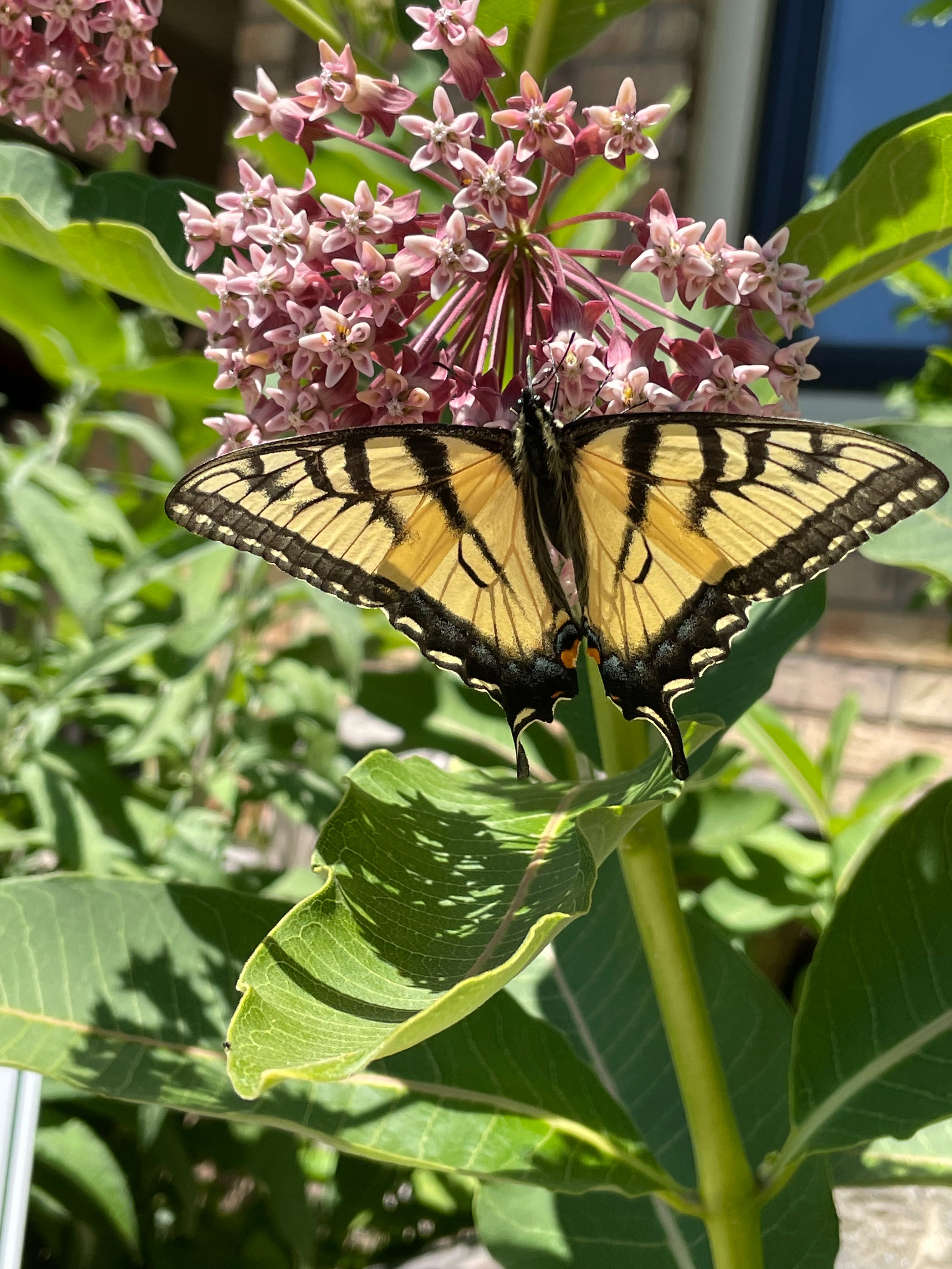
Our garden wildlife
We love our garden wildlife and support it where we can by planting native plants and creating ideal habitats for every creature big and small.
Eastern Tiger Swallowtail
It is very hard to tell if this type of swallowtail is Eastern or Canadian as they sometimes cross breed.
The host plants for the Eastern Tiger Swallowtail are Tulip trees, Hop trees, Cherries, and Ashes
Banded Hairstreak
The Banded Hairstreak is probably the most common Hairstreak in Ontario.
Its host plants are Chestnut oak, White oak, Red oak, American chestnut, Walnuts, and Hickories.
Cheeky chipmunk
Lucky for him we have plenty of raspberries and don’t mind sharing with this cute little guy.
We leave some water out for him and his family in the summer and it brings us so much joy seeing baby chipmunks play along our retaining wall.
Black Swallowtail
We purposely grow lots of parsley and dill to share with the black swallowtails who like to lay their eggs on the plants. During summer we often have 20+ caterpillars on our plants.
Garter snake
The common gartersnake is a relatively small, striped, non-venomous snake.
Scary for some people, but totally harmless! This garden snake is a sign of a healthy garden!
MonarcH butterfly
Milkweed is vital to the survival of this beautiful butterfly now on the endangered species list, it is their only host plant, so please don’t pull your milkweed!
Eastern red-backed salamander
We love these guys! Over the years we found so many in our garden. They love it so much they breed in our compost and we enjoy finding baby salamander everywhere.
They are one species you can protect by leaving your leaves in the spring until it’s consistently above 10 degrees at night!
Potter Wasp
Handy pest control in your garden! The adults feed on flower nectar and collect small caterpillars to feed their young. The caterpillars are paralyzed by the wasp’s sting and stuffed into compartments that the wasp builds out of clay. The female wasp then lays an egg on the stored caterpillars. The potter wasp larva consumes 1 to 12 caterpillars as it grows, making potter wasps important in the natural control of caterpillars.
Braconid wasp Cocoons
Talking about pest control! Check this one out! These cocoons of a parasitoid wasp on a tomato hornworm are your best friend if you want a bountiful tomato harvest!
Using the tomato hornworm as a host these parasitoid will eventually paralyze and kill it after emerging from it after being planted as eggs inside.
Wooly Bee fly
Adults generally feed on nectar and pollen, some being important pollinators. Larvae are mostly parasitoids of other insects like burrowing beetle larvae or wasps.
Fritillary Butterfly
This is one fascinating butterfly! It spends the winter as a newly-hatched caterpillar, hidden in leaf litter. The mum lays eggs near or on the base of violets in the fall, the caterpillar emerges from its egg, but doesn’t eat until the following spring! It also eats in total secrecy. It hides in fallen leaves during the day and only returns to its food plant to feed at night!
Eastern Giant Swallowtail
This is the largest butterfly in North America. It’s mostly black on top and mostly yellow underneath, so when it flies it’s easily mistaken for an Eastern Tiger Swallowtail.Its caterpillar has awesome camouflage - it looks like bird poop! Ha ha ha!
It’s local host plant are different types of prickly ash.
Woolly bear
Woolly bear caterpillars have a reputation for being able to forecast the coming winter weather. If their rusty band is wide, then it will be a mild winter. The more black there is, the more severe the winter.
Woolly bears rely on your leaves in the garden to overwinter, so don’t disturb them till it’s above 10 degrees overnight!
NORTHERN Walkingstick
Also known as Common Walkingstick. This one was a good 10cm long.
Shy and nocturnal, they are most active between 9 PM and 3 AM, so you’re lucky if you encounter one!
Bumble bee
There are 16 different species of Bumble Bees in Ontario. We love watching them trying to get into our cucumber flowers.
Did you know only female bees have a stinger? Male ones don’t!















